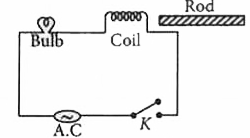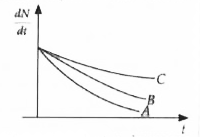The work done to move a charge on an equipotenital surface is Solution in Kannada
infinity
less than 1
greater than 1
zero
The correct Answer is:D
Potential difference between any two points on an equipotential surface , i.e., ΔV=0
Thus, the work done to move a charge (q) on it is
W=qΔV=0
Topper's Solved these Questions
Similar Questions
In the A. C. circuit shown, keeping 'K' pressed, if an iron rod is inserted into the coil, the bulb in the circuit
 05:41View Solution
05:41View SolutionWhich one of the following nuclei has shorter mean life?
 00:32View Solution
00:32View SolutionNo work is done in moving a test charge over an equipotential surface, why?
01:45View SolutionSTATEMENT-1 : Work done to move a charge on the surface of metal solid charged cylinder is always zero.
and
STATEMENT-2 : Work done to move a charge on an equipotential surface is zero.02:30View SolutionWork done in moving a charge on the surface of a charged metallic sphere is ……………. .
01:40View SolutionNo work is done in moving a test charge over an equipotential surface. Why?
02:04View SolutionIs work to be done to move a charge on a surface of an isolated charged conductor ?
01:28View SolutionWork done in moving a positive charge on an equipotential surface is
02:37View SolutionWhat is the work done in moving a test charge over the surface of an isolated charged metal sphere.
01:44View SolutionSTATEMENT-1 : Work done to move a charge on the surface of metal solid charged cylinder is always zero.
and
STATEMENT-2 : Work done to move a charge on an equipotential surface is zero.02:45View SolutionWork done in moving a charge q coulomb on the surface of given charged conductor of potential V is
View Solutionwork done in moving a unit negative charge on an equipotential surface is
03:00View SolutionWork done on equipotential surface to move a charge is negative.
01:31View SolutionWill any work be done in moving a charge +8 between two points on the surface of an isolated charged metallic sphere?
02:42View SolutionWhat is the work done in moving a charge between two points on an equipotential surface?
01:52View Solution

